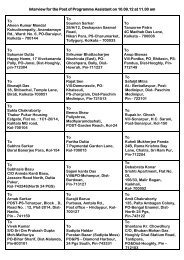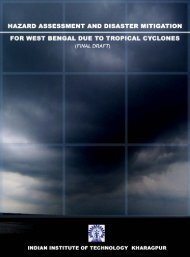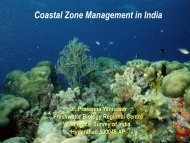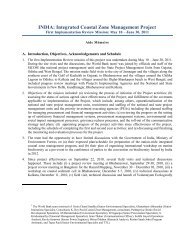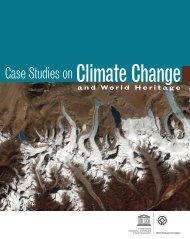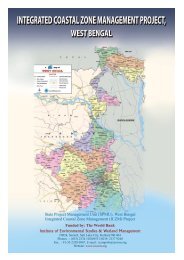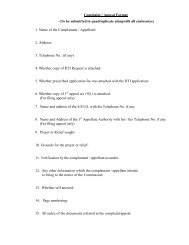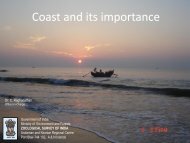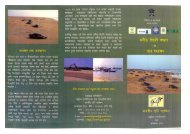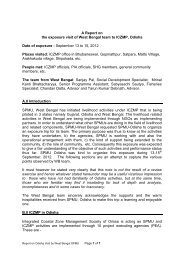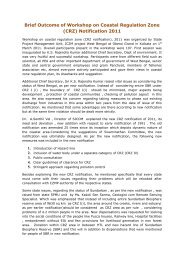Institute of Environmental Studies Wetland Management Project ...
Institute of Environmental Studies Wetland Management Project ...
Institute of Environmental Studies Wetland Management Project ...
- No tags were found...
Create successful ePaper yourself
Turn your PDF publications into a flip-book with our unique Google optimized e-Paper software.
<strong>Institute</strong> <strong>of</strong> <strong>Environmental</strong> <strong>Studies</strong> <strong>Wetland</strong> <strong>Management</strong><strong>Project</strong> SummaryIntegrated Coastal Zone <strong>Management</strong> <strong>Project</strong> is one <strong>of</strong> the environmental projects thathave been launched with the objective <strong>of</strong> ameliorating the staggering and depletingconditions <strong>of</strong> the coastal ecosystem. The state <strong>of</strong> West Bengal has a coastal stretch <strong>of</strong>220 km that has been fraught with serious environmental challenges that have seriousimplications on the sustenance <strong>of</strong> the coastal denizens apart from the perspective <strong>of</strong>phytology as well as ethology. The Government <strong>of</strong> West Bengal has created a specialpurpose vehicle, called the West Bengal State <strong>Project</strong> <strong>Management</strong> Unit (SPMU), and hasappointed the <strong>Institute</strong> <strong>of</strong> <strong>Environmental</strong> <strong>Studies</strong> & <strong>Wetland</strong> <strong>Management</strong> (IESWM) to bethe SPMU.IESWM has been working in the coastal areas <strong>of</strong> West Bengal using mainly remotesensing (RS) & geographical information system (GIS) technology for the last 20 years.One <strong>of</strong> the major thrust areas where RS and GIS technology has been immensely usefulwas in the field <strong>of</strong> coastal zone management which is exclusively the domain <strong>of</strong> activity<strong>of</strong> one <strong>of</strong> the divisions [Coastal <strong>Studies</strong> Division (CSD)] <strong>of</strong> IESWM. The activities <strong>of</strong> CSDare presently being carried out in collaboration with Space Applications Centre (SAC),National Remote Sensing Agency (NRSA), Ministry <strong>of</strong> Environment & Forests (MOEF) andMinistry <strong>of</strong> Earth Sciences, Government <strong>of</strong> India (GOI). Major activities <strong>of</strong> CSD <strong>of</strong> IESWMin the field <strong>of</strong> coastal zone studies & management are preparation <strong>of</strong> natural resourcesinventory and formulation <strong>of</strong> management plans pertaining to coastal wetlands,mangroves, coral reefs, etc., monitoring <strong>of</strong> basic physical processes operative in theestuarine and near shore areas, implications <strong>of</strong> climate change and related phenomenain the coastal regime <strong>of</strong> West Bengal. Progressively greater emphasis is being giventowards acquiring <strong>of</strong> instrumental and computational facilities for building up <strong>of</strong> formprocess-materialinteraction models currently operative and also expected underdifferent climatic scenarios in different segments <strong>of</strong> West Bengal coast.Till recently majority <strong>of</strong> research works involved use <strong>of</strong> both visual and digital imageprocessing techniques for mapping and inventorying purposes supplemented by detailedground truth verification for form identification and mapping. Subsequently techniquesrelating to Geographical Information System (GIS), Global Positioning System (GPS),and Differential Global Positioning System (DGPS) etc were introduced for a multidisciplinaryapproach. Very recently, dynamic process and material monitoring inestuarine and near shore areas including time lapse recording <strong>of</strong> bathymetry, tidalranges, wave period, tide and wave velocity, sediment size etc have been introduced.Noting the work carried out by this division <strong>of</strong> IESWM in the coastal zone, Ministry <strong>of</strong>Environment & Forests, Government <strong>of</strong> India has recognised IESWM as an authorisedinstitute for demarcation <strong>of</strong> High Tide Line (HTL), Low Tide Line (LTL) and CoastalRegulation Zone (CRZ) along the Indian coast in 1998.The list <strong>of</strong> important on-going projects to be executed by IESWM is as follows:•Preparation <strong>of</strong> Integrated Coastal Zone <strong>Management</strong> Plan for identified coastalstretches <strong>of</strong> West Bengal•Coastal zone studies for West Bengal and Andaman Islands•Ecosystem modelling <strong>of</strong> parts <strong>of</strong> Sundarban•Development <strong>of</strong> location specific oil spill trajectory models (OSTM) along Hugliestuary under ‘COMAPS’ programmeThrough different activities carried out during last 15 years or so, CSD <strong>of</strong> IESWM hascollected and is collecting data on coastal processes <strong>of</strong> West Bengal. Some <strong>of</strong> theimportant works, which have already been carried out along coast are mentioned below:
and water providing natural food for estuarine fish, prawns, crab species. Besides thedense mangrove forests <strong>of</strong> the Sunderban also provide shelter and nursery ground forthe fry and fingerlings and the juveniles <strong>of</strong> the estuarine and <strong>of</strong>fshore species. However,the entire coastal ecosystem <strong>of</strong> Sundarban is fragile in nature and it is on the threshold<strong>of</strong> change due to natural and man induced processes. The salinity pr<strong>of</strong>ile <strong>of</strong> the IndianSundarban is on the increase as a consequence <strong>of</strong> change in course <strong>of</strong> River Ganges.Because <strong>of</strong> this some <strong>of</strong> the mangrove species (such as Herittierafomes) is facingextinction. Necessary municipal services to treat the wastes are however yet to developto a satisfactory level. As a consequence the threat <strong>of</strong> pollution <strong>of</strong> the coastal stretches ishigh. It is imperative therefore regular and on-the-spot chemical and biological analysisespecially <strong>of</strong> coastal water are carried out to have an insight into the level <strong>of</strong> pollution,organize site-specific measures and ultimately make it a part <strong>of</strong> the integrated coastalzone management <strong>of</strong> West Bengal coast. Since the coastal areas <strong>of</strong> West Bengalespecially the Sundarban part are not readily accessible and far from the areas where an<strong>of</strong>f-site laboratory could be set up, the necessity <strong>of</strong> procuring a mobile laboratory havingthe facilities <strong>of</strong> some basic analysis is justified. Data produced through such analysis willbe utilized for climate change study.It has been envisaged that such a mobile laboratory could be built on a truck chassisfitted with furniture and equipment / instruments, electrical wiring, water supplypipelines, wash basins etc. There will be a single outlet point <strong>of</strong> electrical line, where anelectrical connection will be made during operation. Similar is the case with watersupply. In normal condition this mobile laboratory will be kept at the head quarter inKolkata. But during the period <strong>of</strong> sampling for investigation and monitoring, the mobilelaboratory will move to the field and electrical connection, water supply connections etc.will be made. In case, electrical connection is not available, diesel generator will bepressed into service and water supply will be made using a mini pump. All instrumentsand equipment will be firmly strapped within the laboratory body so that these do notget damaged during transportation. Initial estimated cost <strong>of</strong> the mobile laboratory is`60.40 lakhs.Social Screening, R & R and need for land acquisitionThe field monitoring equipment are to be procured under this program will be deployedat sites within coastal part <strong>of</strong> West Bengal especially in Sundarbans under thesupervision <strong>of</strong> scientific staff members <strong>of</strong> IESWM. The laboratory equipment will beinstalled in the already existing laboratory facilities <strong>of</strong> IESWM. It will not involve anyacquisition <strong>of</strong> private land and will not affect the community adversely. Hence socialscreening and drawing up <strong>of</strong> R & R plan as mandated by the World Bank are not requiredin the present context.Apart from general strengthening <strong>of</strong> the facilities in the RS & GIS laboratory, suchaugmentation will support building up <strong>of</strong> a model <strong>of</strong> coastal response in both form andprocess elements in the Sundarban in the face <strong>of</strong> an on-going climate change on aregional basis.<strong>Environmental</strong> AssessmentsThe implementation <strong>of</strong> the project will not have any bearing on ecology and environment<strong>of</strong> the locality. The design and minor modifications <strong>of</strong> the laboratory space will involveonly minor indoor renovation works. The running <strong>of</strong> the instruments will not involvehazardous activities and storage or use <strong>of</strong> harmful substances, neither will there be anyharmful emission/generation <strong>of</strong> air/water/solid waste. Construction and operation <strong>of</strong>permanent tide gauge stations are not likely to pose any adverse environmental impactas these stations are small in size to be located on estuaries themselves. There is noneed for a detailed environmental assessment.
Cost <strong>of</strong> Operation & Maintenance, revenue recovery plans, proposed tariffs,subsidy levelsThe instruments to be procured will be operated by trained personnel. Therefore training<strong>of</strong> research staff members is imperative. Proper maintenance also requires that themanufacturer provide adequate and required spares for any repair. Manufacturer is alsorequired to carry out preventive maintenance at required intervals.Operation cost involving use <strong>of</strong> infrastructural facilities like electricity, etc <strong>of</strong> the procuredinstruments will be borne by IESWM through its regular operation <strong>of</strong> the departmentallaboratories. The maintenance cost <strong>of</strong> the procured instruments through AMC has beenestimated at `10,00,000/- per year for the second and third year. As indicated in O & MPlan above, the cost <strong>of</strong> operation relating to capacity building will be met from fundtransferred by IESWM to the corpus fund <strong>of</strong> the ICZM project authority. The tariff for theuse <strong>of</strong> the facilities by external agencies during spare time <strong>of</strong> the instruments will befixed by IESWM as per prevailing national/international rate. No additional financialsupport from the Government has been envisaged.Expected OutcomeThe expected outcome <strong>of</strong> the <strong>Project</strong> is augmentation in instrumental facilities forresearch in IESWM. The other outcome is building up <strong>of</strong> a pool <strong>of</strong> trained scientificmanpower conversant with advanced instrumental facilities to take up cutting edgeresearch in the above two fields <strong>of</strong> study. The third outcome is a contribution towardsunderstanding response <strong>of</strong> coastal processes in Sundarban due to climate change andrelated issues. Peoples’ perception <strong>of</strong> the Sundarban eco-system will be realized throughthe activities <strong>of</strong> the proposed Interpretation Centre by Tagore Research Society. This willbe a significant outcome involving the people at the grass root level.Livelihood Development <strong>of</strong> the Disadvantaged Sectionsin Sagar IslandAn estimated 15000 families constitute the poor and marginalized in Sagar Island. Atabout 8000 to 10000 families live in close proximity to embankment areas. The poor areeither landless or small and marginal farmers. They work as agricultural laborers andwage laborers in fishing trawlers. Many <strong>of</strong> them especially the womenfolk engage inprawn/shrimp seed collection to eke out their living and in the process an irreparabledamage has been caused to the biodiversity. Livelihood assessment in Sagar Islandreveals that the livelihood options are quite limited to these poverty stricken people asbulk <strong>of</strong> them has to fend for them by engaging themselves in household chores, smallretail outlets apart from shrimp seed collection. Further the number <strong>of</strong> employment/workdays <strong>of</strong> the poor is relatively less. Also the poor are not engaged in any kind <strong>of</strong> valueaddition activities thus occupying the lower rungs <strong>of</strong> the value chain.Therefore the Livelihood Development <strong>of</strong> Disadvantaged Sections in Sagar Islandcomponent proposes the following to enhance the livelihoods <strong>of</strong> the Sagar islanders:•Organize women and youth around savings, credit and micro-insurance in to SHGs•Undertake participatory livelihoods• Include pro-active eco-support and natural resource enhancing activities like RWH,tourism and tourism-based livelihoods•Include livelihoods enabling infrastructure like vocational training centers, procurementcenters, work sheds for enterprises, shops/outlets, skill building centers•Facilitate bank linkages and convergence with other programs•Utilize the maintenance funds for embankment for enhancing livelihoods as revolvingfunds•Build skills <strong>of</strong> the youth in vocational training centers for meeting the services requiredin the island•Explore the employment opportunities outside the island and provide them training inthese opportunities for placement
The budget for the livelihood component <strong>of</strong> the five year Sagar pilot is Rs 2779.00 lakhswith the following work element break-up:♦ Support for institutions <strong>of</strong> livelihood♦ Community mobilization – Institution and capacity building♦ Funds to the community for enhancing livelihood♦ Revolving funds for community institutions♦ Funds for skills for gainful employment♦ Funds for livelihoods and business development♦ Incentive funds for pro-poor Gram Panchayats♦ Funds for innovative ideas in livelihood♦ Support to livelihood – capacity building♦ Support to livelihoods – livelihoods and business supportThe project component intends to provide the requisite support to the NGOs forcoordinating the livelihood improvement programme that will have strong marketlinkages in conjunction with skill up-gradation and financial bonding at the grass rootlevel. The NGOs will be actively involved in the formation <strong>of</strong> SHGs & federations throughwhom the devolution <strong>of</strong> resources will take place for enhancement <strong>of</strong> a better standard<strong>of</strong> living.Sundarban Interpretation CentreIESWM in collaboration with Tagore society for Rural Development will constructSundarban-an interpretation centre which will reflect the interaction <strong>of</strong> Science,Technology and Society in the Sundarbans. The proposed interpretation Centre is comingup at Rangabelia at the Gosaba Block <strong>of</strong> South 24 Pargana district <strong>of</strong> the state <strong>of</strong> WestBengal. Unlike a traditional museum-like institution only with visual impact, theSundarbanis planned to involve all five senses <strong>of</strong> visitors - the visual, auditory,olfactory, gustatory, and tactile perceptions leading to a complete understanding <strong>of</strong> theimpact <strong>of</strong> environment on the life <strong>of</strong> a common man. With its richness <strong>of</strong> hands-onexhibits, interactive computer multimedia, target-oriented training facilities, fullycomputerized information bank with cyber library and exposure to creativity, theSundarban is aimed at the betterment <strong>of</strong> life through emotional involvement <strong>of</strong> the localpopulace. The main objectives behind the development <strong>of</strong> Sundarban are to developspirit <strong>of</strong> inquiry by encouraging curiosity and questioning process, and create a scientifictemper in the society and to inculcate an ability to identify the problems and worktowards appropriate solution with scientific attitude for betterment <strong>of</strong> the lives <strong>of</strong> thepeople <strong>of</strong> the Sundarbans.Sundarban will provide a plethora <strong>of</strong> items showcasing various debatable topics incommon parlance e.g.♦ The Sundarbans - study <strong>of</strong> geo-morphology, environment and ecology♦ Soil <strong>Management</strong> - causes and effects <strong>of</strong> soil erosion, remedial measures,protection<strong>of</strong>the embankment♦ Disaster <strong>Management</strong> - protection from Cyclone, Flood, Tsunami and resultingsalination♦ <strong>of</strong> soil♦ Global Warming -- contributing factors, resulting disasters and protection♦ Freedom from Hunger -- agriculture, animal husbandry, apiary, pisciculture♦ Health &Nutrition - public health and hygiene, cause <strong>of</strong> diseases and healthservices,malnutrition and balanced food♦♦♦♦Shelter - cost-effective disaster-pro<strong>of</strong> housing, disaster sheltersRenewable Energy -- solar, bio-gas, tidal - both indoor and outdoor exhibitsTransport & CommunicationPeople & Culture
The Interpretation Centre will deploy various communication techniques and tools fordemonstrating audio-visual effects <strong>of</strong> eco-degenerating and eco-friendly on-goingssupported by scientific and technological inputs for proper understanding <strong>of</strong> commonerfor the very existence <strong>of</strong> the Sundarbans and its inhabitants.Capacity Buildinga) Training <strong>of</strong> NGO workers in the use <strong>of</strong> audio-video equipment, and educational aidsfor communicating with the people on topics related to their everyday lifeb) Training <strong>of</strong> teachers, in primary and secondary schools, in the use <strong>of</strong> audio-videoequipment, and educational aids, with a view to train up young school children incommunity development activitiesc) Development <strong>of</strong> women power through training and exposure-oriented programsThe administrative expense <strong>of</strong> Rs.20,000 per month shall include the expenses <strong>of</strong>electricity, Phone, internet connection, postage, travel, transport andcontingencies.Income from the entrance fee shall be less than 20% <strong>of</strong> the annual O&Mexpenses. The balance has to be raised through private sponsorship and governmentalsupport at the initial stage. The success <strong>of</strong> the Centre in organizing useful programs shalltaper <strong>of</strong>f the governmental support.Neither techno-economic viability nor cost-benefit analysis in the true sense is a differentproposition as the benefits that will accrue will be <strong>of</strong> social nature and mostly intangible.This may be considered as an investment for future will long time lag. But benefits thatwill flow out will definitely be much larger than the cost involved.Increase in footfalls will indicate the interest and involvement <strong>of</strong> the local population,specially the younger generation such as high school students, members <strong>of</strong> youth clubsetc.The Centre shall concentrate not only on the exhibits but also the integrateddevelopment activities to be carried out both in house and outreach by the extensionstaff. This kind <strong>of</strong> all-round contact will create public awareness <strong>of</strong> the problems andprojected solutions for elevating their standard <strong>of</strong> life.In course <strong>of</strong> time, the Interpretation Centre will be a focal point <strong>of</strong> both overseas andother Indian tourists among whom Sundarbans has been an area <strong>of</strong> specialized interest.





